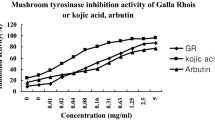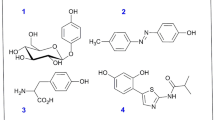Abstract
In this study, we present evidence that cotreatment of aloesin and arbutin inhibits tyrosinase activity in a synergistic manner by acting through a different action mechanism. Aloesin or arbutin similarly inhibited enzyme activity of human- and mushroom-tyrosinases with an IC50 value of 0.1 or 0.04 mM, respectively. Lineweaver-Burk plots of the enzyme kinetics data showed that aloesin inhibited tyrosinase activity noncompetitively with a Ki value of 5.3 mM, whereas arbutin did it competitively (Maeda, 1996). We then examined whether cotreatment of these agents inhibits the tyrosinase activity in a synergistic manner. The results showed that 0.01 mM aloesin in the presence of 0.03 mM arbutin inhibited activity of mushroom by 80% of the control value and the reverse was also true. The inhibitory effects were calculated to be synergistic according to the Bürgi method. Taken together, we suggest that aloesin along with arbutin inhibits in synergy melanin production by combined mechanisms of noncompetitive and competitive inhibitions of tyrosinase activity.
Similar content being viewed by others
References Cited
Funayama, M., Arakawa, H., Yamamoto, R., Nishino, T., Shin, T. and Murao, S., Effects of alpha-and beta-arbution on activity of tyrosinases mushroom and mouse melanoma (1995).Biosci Biotechnol Biochem., 59(1), 143–144 (1995)
Lerch, K., Monophenol monooxygenase from Neurospora crassa.Methods Enzymol., 142, 165–169 (1987).
Maeda, K. and Fukuda, M.,In vitro effectiveness of several whitening cosmetic components in human melanocytes.J. Soc. Chem., 42, 361–368 (1991).
Maeda, K., Fukuda, M., Arbutin: mechanism of its depigmenting action in human melanocyte culture.J. Pharmacol Exp Ther., 276(2), 765–769 (1996).
Mason, H. S.,Annu. Rev. Bichem., 34, 595–634 (1965).
Mishima, Y., Hatta, S., Ohyama, Y. and Inazu, M. Induction of melanogenesis suppression: cellular pharmacology and mode of differential actionPigment Cell Res., 1(6), 367–374 (1988).
Morrison, M. E., Yagi, M. J., Cohen, G.,In vitro studies of 2,4-dihydroxyphenylalanine, a prodrug targeted against malignant melanoma cells.Proc Natl Acad Sci USA, 82(9), 2960–4 (1985)
Okabe, S., Takeuchi, R., Urushidani, T. and Murata, T., Effects of aluminum hydroxide- magnesium oxide(AH MO), Dicyclomine HCL and AH-MO+Dicyclomine HCL on acute gastric ulcers in experimental animals.Applied Pharmacology (Japan), 12(5), 759–764 (1976).
Pawelek, J. M., Factors regulating growth and pigmentation of melanoma cells.J Invest Dermatol., 66(4), 201–209 Review (1976).
Pomerantz, S. H., Separation, Purification, and Properties of Two Tyrosinases from Hamster Melanoma.J. Biol. Chem., 238, 2351–2357 (1963).
Robert, C., Hider and Lerch, K., The inhibition of tyrosinase by pyridinonesBiochem. J., 257, 289–290 (1989).
Shirota, S., Miyazaki, K., Aiyama, R., Ichioka, M. and Yokokura, Tyrosinase inhibitors from crude drugs.Biol Pharm Bull., 17(2), 266–9 (1994).
Smith, C. J., OHare, K. B., Allen, J. C., Selective cytotoxicity of hydroquinone for melanocyte-derived cells is mediated by tyrosinase activity but independent of melanin content.Pigment. Cell Res., 1(6), 386–389 (1988).
Wittbjer, A., Odh, G., Rosengren, A. M., Rosengren, E. and Rorsman, H., Isolation of soluble tyrosinase from human melanoma cells.Acta. Derm. Venereol., 70(4), 291–294 (1990).
Yagi, A., Kanbara, T. and Morinove, N., Inhibition of mushroom-tyrosinase by Aloe extract.Planta Medica., 515–517 (1987).
Author information
Authors and Affiliations
Rights and permissions
About this article
Cite this article
Jin, Y.H., Lee, S.J., Chung, M.H. et al. Aloesin and arbutin inhibit tyrosinase activity in a synergistic manner via a different action mechanism. Arch Pharm Res 22, 232–236 (1999). https://doi.org/10.1007/BF02976355
Received:
Issue Date:
DOI: https://doi.org/10.1007/BF02976355




